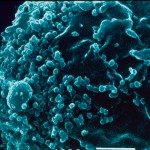Lien vers Pubmed [PMID] – 25392215
Lien DOI – 10.1128/JVI.01730-14
J Virol 2015 Jan; 89(2): 1329-39
In order to develop strategies to prevent HIV-1 (human immunodeficiency virus type 1) transmission, it is crucial to better characterize HIV-1 target cells in the female reproductive tract (FRT) mucosae and to identify effective innate responses. Control of HIV-1 infection in the decidua (the uterine mucosa during pregnancy) can serve as a model to study natural mucosal protection. Macrophages are the main HIV-1 target cells in the decidua. Here we report that in vitro, macrophages and T cells are the main HIV-1 targets in the endometrium in nonpregnant women. As reported for decidual macrophages (dM), endometrial macrophages (eM) were found to have an M2-like phenotype (CD68+ CD163+ CD206+ IL-10high). However, eM and dM may belong to different subpopulations, as they differently express certain markers and secrete different amounts of proinflammatory and anti-inflammatory cytokines. We observed strong expression of the SAMHD1 restriction factor and weak expression of its inactive form (pSAMHD1, phosphorylated at residue Thr592) in both eM and dM. Infection of macrophages from both tissues was enhanced in the presence of the viral protein Vpx, suggesting a role for SAMHD1 in the restriction of HIV-1 infection. This study and further comparisons of the decidua with FRT mucosae in nonpregnant women should help to identify mechanisms of mucosal protection against HIV-1 infection.The female reproductive tract mucosae are major portals of HIV-1 entry into the body. The decidua (uterine mucosa during pregnancy) can serve as a model for studying natural mucosal protection against HIV-1 transmission. A comparison of target cells and innate responses in the decidua versus the endometrium in nonpregnant women could help to identify protective mechanisms. Here, we report for the first time that macrophages are one of the main HIV-1 target cells in the endometrium and that infection of macrophages from both the endometrium and the decidua is restricted by SAMHD1. These findings might have implications for the development of vaccines to prevent HIV-1 mucosal transmission.







